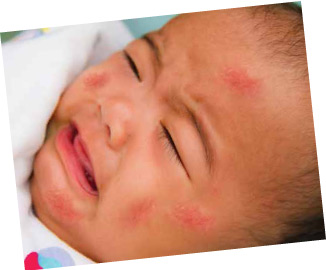Eczema, or atopic dermatitis, is a skin condition that often results in uncontrollable itching, inflamed red patches of dry skin, and can be irritating and painful, especially for children. While it is not curable (the same as asthma), it is treatable and can be managed with the proper care and approach.
Approximately 20 – 30% of children who suffer from asthma will also have eczema. Due to the high incidence of eczema, every child with asthma will be checked by the doctor for signs and symptoms of eczema. However, children are not required to go through a test for allergy.
Why eczema occurs
This condition typically occurs due an absence of a type of protein in the skin cells which causes the skin to lose its ability to retain water, thus making it dry. As a result of the dry skin, it becomes easily irritated; this itchy sensation is why children start scratching, and this in turn causes lesions to form.
Bacteria will accumulate in the lesions and start growing, and when this happens, the skin will feel even more irritated and the itching sensation increases. This will only worsen the problem, and the only way to get around this problem is to keep the skin moisturised. In doing so, the skin is soothed thus helping children to stop scratching at their injured skin.
Dealing with eczema
There are some simple do’s and don’ts in order to deal with eczema, and these include the following:
What you can do
For cases of mild eczema, these can usually be treated by the paediatrician only. It involves using some form of non-scented, fragrance-free soap/body wash that contains moisturising agents. After baths, immediately follow up with moisturisers and/ or aqueous cream (with 20% glycerine for the skin). If you prefer, you can also use the aqueous cream as a replacement for soap/ body wash. The use of glycerine will help to maintain the moisture content of your child’s skin for longer periods.
However, if your child suffers from moderate to severe eczema, his or her specialist will need to work hand-in-hand with a dermatologist in order to figure out the correct method to tackle his or her condition, and this may involve the use of steroid creams or skinwraps.
Important tip:
Always use dermatologically tested products. Do not use products that are scented, have fragrances, or contain alcohol as the chemicals used may irritate your child’s skin. Expensive products do not necessarily mean they are better.
DIY skin-wraps:
- Wet clean gauze bandages with water.
- Apply moisturiser and wrap the affected skin.
- Cover the wet bandages with dry bandages/towel to lock in the moisture.
- Leave overnight.







Komen